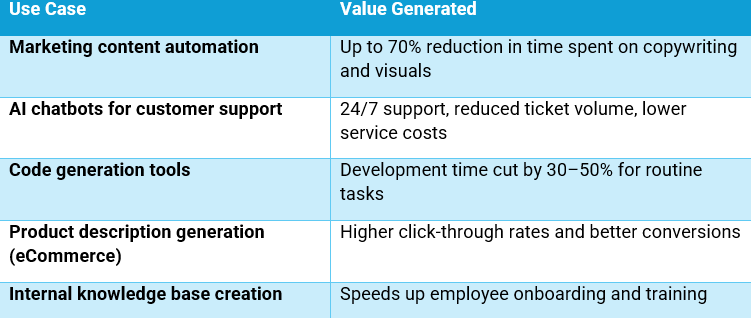With 2025 shaping up to be the year of AI accountability, businesses are no longer asking “Can we use GenAI?”, they’re asking “Should we?” and “Will it pay off?”
The hype around generative AI has sparked interest across every industry, but the real differentiator in today’s market isn’t experimentation, it’s execution. For companies adopting AI to actually see results, the question isn’t whether the tech is impressive, but whether it generates tangible ROI.
Let’s explore how leading businesses are moving from playing with GenAI to measuring its impact and what lessons can help others make that leap.
What Is Generative AI ROI and Why Does It Matter?
Generative AI ROI refers to the measurable return a business gets from using GenAI tools and technologies. While cost savings are a big part of the equation, ROI also includes:
- Faster content production (blogs, product descriptions, visuals)
- Reduced development time via code generation
- Enhanced customer support through AI chatbots
- Better personalization, leading to increased engagement and conversions
It’s not about novelty anymore, it’s about value-driven AI implementation that aligns with real business goals.
Key Business Use Cases With Proven ROI
Here are some real-world business use cases for generative AI that are already delivering measurable results:

These examples show that generative AI for enterprise is no longer theoretical. It’s a practical, scalable tool that saves time and improves efficiency when deployed with intent.
Cost vs Value: How to Evaluate GenAI Investments
Before diving in, businesses should carefully weigh the cost vs value of generative AI.
Costs may include:
- Licensing or subscription fees
- Integration with existing systems
- Staff training and change management
Value may include:
- Reduced reliance on external vendors
- Faster delivery cycles
- Increased output without expanding headcount
- Better customer engagement and satisfaction
Importantly, ROI from AI tools may not be immediate. A 3–6 month evaluation window is often realistic for tracking meaningful gains.
How to Drive Value-First Adoption of GenAI
The most successful companies start small but strategic. Here’s how to implement GenAI with ROI in mind:
- Choose testable, high-impact use cases (e.g. internal docs, marketing content)
- Assign ownership to track outcomes
- Set clear KPIs output speed, quality, engagement, etc.
- Compare results to manual processes
- Promote human + AI collaboration, rather than pure automation
This phased approach allows for iteration, early wins, and trust-building across teams.
Challenges to Watch Out For
Even with its potential, generative AI comes with risks. Keep an eye out for:
- Over-automation, leading to poor content quality or user experience
- Data security & compliance concerns with sensitive inputs
- Hidden costs in scaling and customizing GenAI tools
- Employee resistance or skill gaps
Addressing these early can help ensure that GenAI adoption remains sustainable and aligned with business goals.
Conclusion: The GenAI Goldmine Is Real
Generative AI isn’t just a trend, it’s a transformation engine. But like any tool, it only delivers ROI when implemented with intention, monitored carefully, and aligned with real business problems.
The companies already tracking outcomes: cost savings, time reduction, increased conversions, are the ones scaling fastest. GenAI has the power to revolutionize business processes. The question is: Are you measuring what matters?
At I NET Software Solutions, we help businesses turn AI experimentation into real results. From use case discovery to implementation and optimization, our data science and AI services are designed to deliver measurable ROI.
Ready to turn GenAI into real business value?
Book your AI value session with I NET Software Solutions
If you’re interested in how data science is driving smarter, faster business decisions, you might also like our blog:
How Data Science Is Transforming Business Decision-Making in 2025, it explores how companies are leveraging data to not only predict trends but to act on them in real time.
